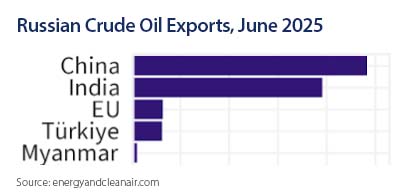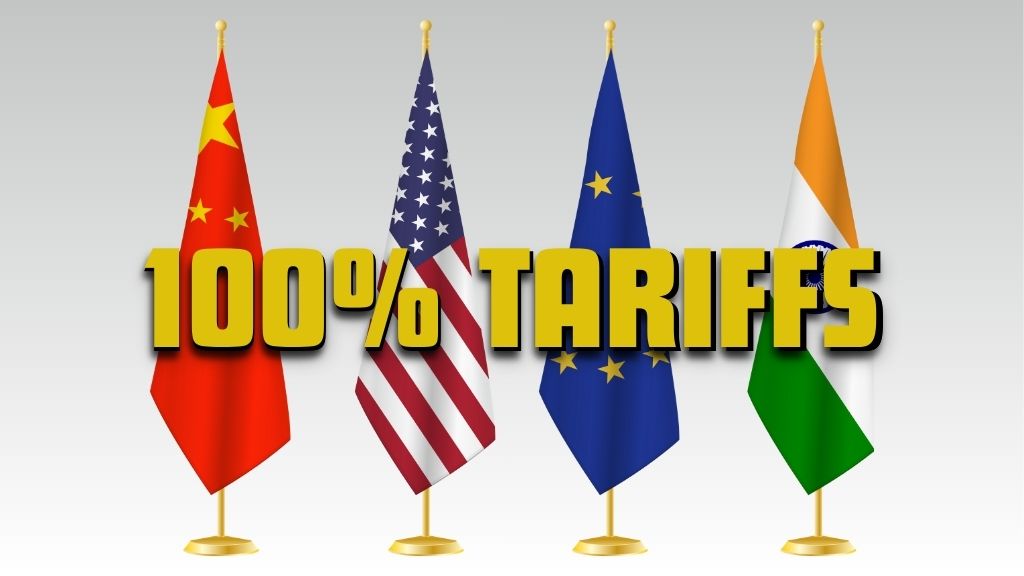Update: September 11
The European Union has rejected US President Donald Trump’s request to impose high tariffs on some goods from China and India, arguing that the bloc does not use tariffs as a sanctions tool. As we mention in this article, this decision will also carry implications for the EU as concerns its relations with the United States and in particular as concerns its stance as regards Ukraine.
US President Donald Trump and the European Commission have been discussing a new round of secondary sanctions to be placed on China and India to ‘persuade’ them to stop buying Russian oil. Conversations were held by phone yesterday (September 9) and included plans to levy EU and US import tariffs of up to 100% on all Chinese and Indian goods entering their markets.
A US official stated after the meeting that “The President’s view is, let’s all put on dramatic tariffs and keep the tariffs on until the Chinese and Indians agree to stop buying the oil. There really aren’t many other places that oil can go.” Yet Trump has also made it clear that the United States would only impose the proposed 100% tariffs if Europe does.
There are significant complications, not least that the EU itself continues to buy Russian oil, both directly and indirectly. The EU was the third largest buyer in June 2025, after China and India, and additionally purchased crude oil imports from Turkiye whose imports include Russian crude in its mix.

Trump, of course, is on a winner here, while the EU is being increasingly tied into knots. If the EU agrees, it will need to replace whatever oil supplies it currently obtains from Russia as it cannot impose sanctions upon China and India while continuing to buy its own share from the same source. That means it will be forced to buy from alternative suppliers – such as the United States.
It would also mean that all Chinese and Indian products to be exported to the EU – and China in particular manufactures a huge amount of Christmas and New Year gifts and accessories – would also need to be sourced from other markets and at very tight deadlines – unless certain product categories are exempted. The same, but to a lesser degree, also impacts US retailers.
On the other hand, if the EU does not take Trump’s offer to simultaneously impose 100% tariffs, he can suggest that “Europe doesn’t want to end the war” which creates significant political and financial problems for the EU in its own right.
The main product categories that China and India export to Europe and the United States are as follows:
China
Total EU and US exports value: US$1.69 trillion
Main exports: Electronics (including broadcasting equipment, computers, and integrated circuits), White Goods, Toys, Games, Sports equipment, Furniture, Apparel, Batteries, EV equipment.
India
Total EU and US exports value: US$163 billion
Main exports: engineered goods, pharmaceuticals, electronics (including smartphones), textiles, chemicals, jewellery, and agricultural produce.
There is no doubt that imposing secondary sanctions on China and India to this extent would create serious difficulties with both countries’ manufacturing sectors. It would also raise a flurry of lawsuits as Western importers would look to cancel legally binding orders. The real question at hand is whether Trump really means it and if the EU has the strength to impose such a measure.
In making additional proposals, another EU initiative is to completely ban the issuing of travel visas of any type to Russian citizens. 552,630 Schengen visas to Russian nationals were issued in 2024, mostly for vacations, with the primary destinations being Italy, France, Spain, and Greece.
Interestingly, Russian visitors spend significantly more on average per trip than European tourists, with a last, pre-sanctions 2018 study finding they spent €1,431 per head compared to the European average of €1,003. Recent reports suggest that despite the higher costs and longer travel times due to the suspension of direct flights, wealthy Russian travellers are still visiting, opting for luxury accommodations and boutique shopping for brands currently not available in Russia.
While it is a proposal that alienates Russians from Europe, it is also another initiative that comes at a substantial fiscal cost to Europe itself. That tourism spend will be lost and will go to alternative, non-European destinations instead.
Analysis
Our opinion is that Trump is probably bluffing, while the EU will baulk at such a proposal. That, though, is a Trump win, as it gives him the ability to state that the European Union is not serious about imposing tariffs on Russia’s main energy clients to end the Ukraine conflict. In other words, it gives him a potential exit route for the United States to wash its hands of Ukraine and leave it as a European problem to solve.
The implication in this, if correct, is that the European Union has nowhere else left to go as regards Ukraine. It will have been dismissed by Trump as ineffective and insincere while also being left financially weak.
If, on the other hand, they do adopt the 100% measures, their economy leading up to Christmas, New Year and the winter months is going to take a significant hit. The next EU sanctions package is due in a few days. Our bet is that it will be watered down, as the EU cannot afford to do what Trump is asking.
Further Reading
European Union Increases Russian LNG Imports, Yet Threatens To Sanction India and China






